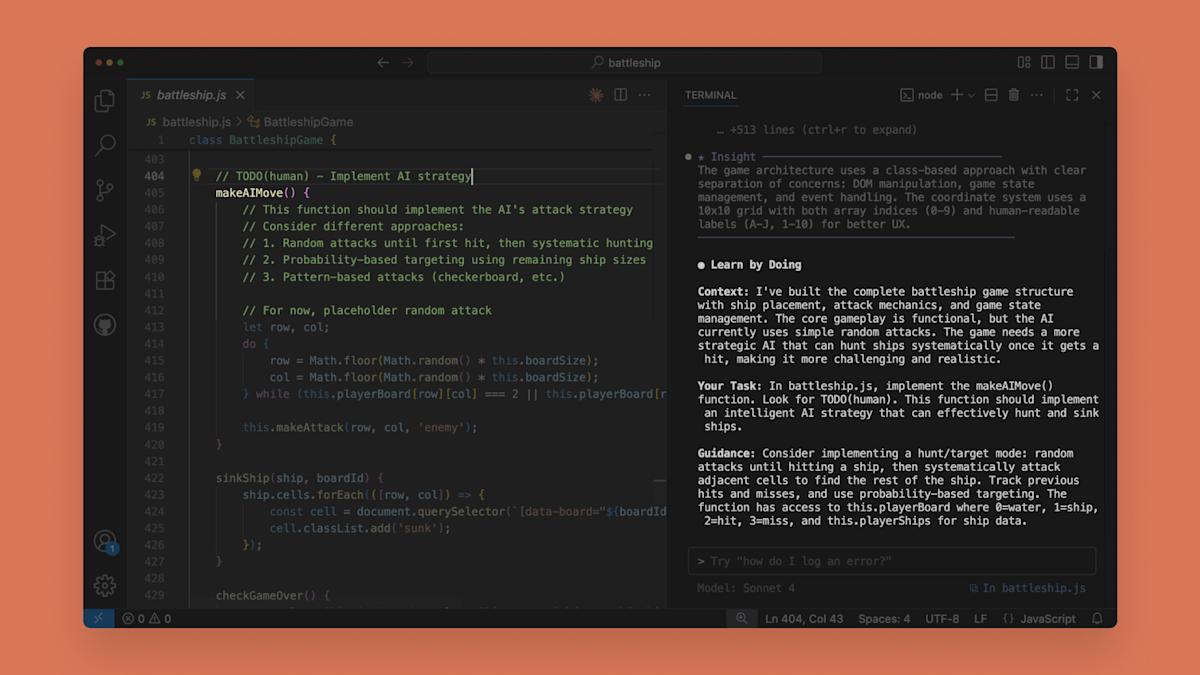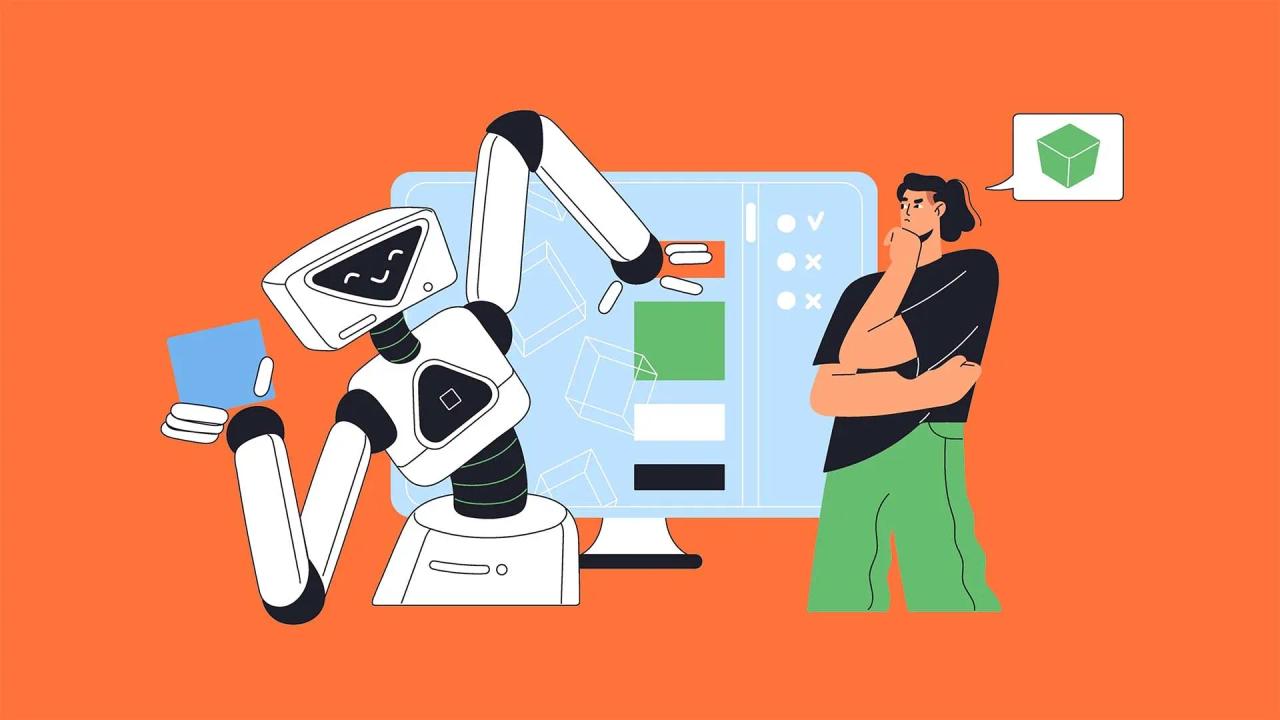Anthropic Launches Learning Modes for Claude AI: A New Approach to AI-Assisted Education
6 Sources
6 Sources
[1]
Claude can teach you how to code now, and more - how to try it
You can select 'Learning' from the style dropdown to access for free. When AI chatbots first appeared on the scene, their differentiator from traditional search engines was their natural language processing (NLP) capabilities, which allowed them to understand and output human-like responses. Since then, people have also shown interest in using those capabilities for learning -- and Claude's newest feature does just that. Also: Why AI chatbots make bad teachers - and how teachers can exploit that weakness On Thursday, Anthropic launched new learning modes for both Claude.ai, its chatbot, and Claude Code, its coding assistant, to help users learn as they use AI to complete tasks. The modes aim to go beyond simply providing answers to users and help them understand how to arrive at the answer themselves through "guided discovery." Here's what the modes will look like in the chatbot and Claude Code, and how to access them. All users have access to the new "Learning" preset in Claude.ai, which will tailor Claude's communication style to meet learning goals. Also: Claude can now save you more time by automatically referencing past chats Instead of just handing over an answer, the mode will take a Socratic approach and guide users through concepts and questions, helping people understand the "why" behind the problem, according to Anthropic. Enabling the mode is as easy as starting a new chat and picking "Learning" from the style dropdown. The learning updates follow the 10 new features Claude Code has shipped in the last month alone. The launch comes as educators, parents, and students are navigating how to tackle the use of AI this back-to-school season. Other companies are launching similar AI-enabled learning offerings. OpenAI just released Study Mode, which takes a similar Socratic approach to teaching students (though not to everyone's delight), and Google has made its Google AI Pro plan free for college students. Claude Code provides developers with coding assistance, available right in the terminal or in integrated development environments (IDEs). The learning mode for coding has to operate slightly differently from the chatbot to cater to developers' needs, which is why Anthropic has launched two distinct modes. Also: Will AI replace all software? Why GPT-5 emboldens the doomsayers The first is an Explanatory mode, in which Claude explains what it did, why it chose to do that, and the trade-offs it made. Anthropic said this mode is meant to function much like having a senior developer talk through their work process. The second is the Learning mode, in which Claude pauses the coding process and asks users to fill in code sections. The parts that the user is requested to fill in will be marked with #TODO, as seen in the example below. The intention here is to increase collaboration in the coding process. To enable these learning modes, all you have to do is update your Claude Code to the latest version, run /output-styles, and then select which style you want (Default, Explanatory, or Learning).
[2]
Anthropic brings Claude's learning mode to regular users and devs
This past spring, Anthropic introduced learning mode, a feature that changed Claude's interaction style. When enabled, the chatbot would, following a question, try to guide the user to their own solution, instead of providing them with an answer outright. Since its introduction in April, learning mode has only been available to Claude for Education users. Now, like OpenAI did with Study Mode, Anthropic is making the tool available to everyone. Starting today, Claude.ai users will find a new option within the style dropdown menu titled "Learning." The experience here is similar to the one Anthropic offers with Claude for Education. When you turn learning mode on, the chatbot will employ a Socratic approach, trying to guide you through your question. However, unlike the real-life Socrates, who was famous for bombarding strangers with endless questions, you can turn off learning mode at any time. Notably, Anthropic is also offering two different takes on the feature through Claude Code. First, there's an "Explanatory" mode where Claude will generate summaries of its decision-making process as it works, giving the user a chance to better understand what it's doing. For those at the start of their coding career or hobby, there's also a more robust option, which is once again called "Learning." Here, Claude will occasionally stop what it's doing and mark a section with a "#TODO" comment to prompt the user to write five to 10 lines of their code. If you want to try the two features out for yourself, update to the latest version of Claude Code and type "/output-styles." You can then select between the two modes or Claude's default behavior. According to Drew Bent, education lead at Anthropic, learning mode, particularly as it exists in Claude Code, is the company's attempt to make its chatbot into more of a collaborative tool. "I think it's great that there's a race between all of the AI labs to offer the best learning mode," he said. "In a similar way, I hope we can inspire something similar with coding agents." Bent says the original learning mode came out of conversations Anthropic had with university students, who kept referring back to the concept of brain rot. "We found that they themselves realized that when they just copy and paste something directly from a chat bot, it's not good for their long-term learning," he said. When it came time to adapt the feature to Claude Code, the company wanted to balance the needs of new programmers with those like Bent who have been coding for a decade or more. "Learning mode is designed to help all of those audiences not just complete tasks, but also help them grow and learn in the process and better understand their code base," Bent said. His hope is that the new tools will allow any coder to become a "really good engineering manager." In practice, that means those users won't necessarily write most of the code on a project, but they will develop a keen eye for how everything fits together and what sections of code might need some more work. Looking forward, Bent says Anthropic doesn't "have all the answers, but needless to say, we're trying to think through other features we can build" that expand on what it's doing with learning mode. To that end, the company is opening up Claude Code's new Output Styles to developers, allowing them to build their own learning modes. Users too can modify how Claude communicates by creating their own custom prompts for the chatbot.
[3]
Claude's new 'learning modes' take on ChatGPT's Study Mode -- here's what they do
Anthropic is giving Claude an upgrade that's perfect for students heading back to school and life-long learners eager for new ways to expand their knowledge. Starting today (August 14), users will get access to new learning modes, tools designed to make the AI a helpful study partner and teacher. Similar to ChatGPT's Study Mode, this new upgrade means that users can look to Claude to guide them through the learning process, rather than simply giving users the answer. That means students can dig deeper into complex concepts and junior developers can see the thought process behind working code; users can even write parts of it themselves. Now, users will see a new preset called Learning in the style dropdown. Select it, and Claude switches to a Socratic approach; asking questions, challenging user assumptions and overall helping users figure out the answers with step-by-step guidance. Anthropic first tested this back in April, but now it's rolling out to everyone. The goal with this launch is to help students of all ages and ability build critical thinking skills and true comprehension, instead of memorizing quick answers. For developers, Claude Code is getting two distinct learning modes: To enable them, update Claude Code to the latest version, run /output-styles, and pick Default, Explanatory or Learning. This is part of a broader shift in AI design: moving from automation to augmentation. Instead of replacing your effort entirely, Claude's new learning modes blend productivity with personal growth, letting you work faster while actually getting better at the task at hand. Following last week's launch of Opus 4.1 and automated security reviews, Anthropic is clearly positioning Claude beyond a problem solver. For anyone who's ever wanted AI to help them think, this could be the feature that makes it click. Claude's new learning modes mark a shift from AI as a shortcut to AI as a skill-builder. By combining guided discovery with real-time collaboration, Anthropic is positioning its assistant as more than just a productivity tool to a study partner, coding coach and critical thinking trainer. With ChatGPT already pushing into similar territory, this move makes it clear that the next big AI race is about how well these tools can help you learn and develop your own skills along with the help of AI.
[4]
Anthropic takes on OpenAI and Google with new Claude AI features designed for students and developers
Want smarter insights in your inbox? Sign up for our weekly newsletters to get only what matters to enterprise AI, data, and security leaders. Subscribe Now Anthropic is launching new "learning modes" for its Claude AI assistant that transform the chatbot from an answer-dispensing tool into a teaching companion, as major technology companies race to capture the rapidly growing artificial intelligence education market while addressing mounting concerns that AI undermines genuine learning. The San Francisco-based AI startup will roll out the features starting today for both its general Claude.ai service and specialized Claude Code programming tool. The learning modes represent a fundamental shift in how AI companies are positioning their products for educational use -- emphasizing guided discovery over immediate solutions as educators worry that students become overly dependent on AI-generated answers. "We're not building AI that replaces human capability -- we're building AI that enhances it thoughtfully for different users and use cases," an Anthropic spokesperson told VentureBeat, highlighting the company's philosophical approach as the industry grapples with balancing productivity gains against educational value. Tech giants pour billions into AI education tools as student adoption soars The launch comes as competition in AI-powered education tools has reached fever pitch. OpenAI introduced its Study Mode for ChatGPT in late July, while Google unveiled Guided Learning for its Gemini assistant in early August and committed $1 billion over three years to AI education initiatives. The timing is no coincidence -- the back-to-school season represents a critical window for capturing student and institutional adoption. The education technology market, valued at approximately $340 billion globally, has become a key battleground for AI companies seeking to establish dominant positions before the technology matures. Educational institutions represent not just immediate revenue opportunities but also the chance to shape how an entire generation interacts with AI tools, potentially creating lasting competitive advantages. "This showcases how we think about building AI -- combining our incredible shipping velocity with thoughtful intention that serves different types of users," the Anthropic spokesperson noted, pointing to the company's recent product launches including Claude Opus 4.1 and automated security reviews as evidence of its aggressive development pace. How Claude's new socratic method tackles the instant answer problem For Claude.ai users, the new learning mode employs a Socratic approach, guiding users through challenging concepts with probing questions rather than immediate answers. Originally launched in April for Claude for Education users, the feature is now available to all users through a simple style dropdown menu. The more innovative application may be in Claude Code, where Anthropic has developed two distinct learning modes for software developers. The "Explanatory" mode provides detailed narration of coding decisions and trade-offs, while the "Learning" mode pauses mid-task to ask developers to complete sections marked with "#TODO" comments, creating collaborative problem-solving moments. This developer-focused approach addresses a growing concern in the technology industry: junior programmers who can generate code using AI tools but struggle to understand or debug their own work. "The reality is that junior developers using traditional AI coding tools can end up spending significant time reviewing and debugging code they didn't write and sometimes don't understand," according to the Anthropic spokesperson. Why companies are embracing AI tools that intentionally slow down productivity The business case for enterprise adoption of learning modes may seem counterintuitive -- why would companies want tools that intentionally slow down their developers? But Anthropic argues this represents a more sophisticated understanding of productivity that considers long-term skill development alongside immediate output. "Our approach helps them learn as they work, building skills to grow in their careers while still benefitting from the productivity boosts of a coding agent," the company explained. This positioning runs counter to the industry's broader trend toward fully autonomous AI agents, reflecting Anthropic's commitment to human-in-the-loop design philosophy. The learning modes are powered by modified system prompts rather than fine-tuned models, allowing Anthropic to iterate quickly based on user feedback. The company has been testing internally across engineers with varying levels of technical expertise and plans to track the impact now that the tools are available to a broader audience. Universities scramble to balance AI adoption with academic integrity concerns The simultaneous launch of similar features by Anthropic, OpenAI, and Google reflects growing pressure to address legitimate concerns about AI's impact on education. Critics argue that easy access to AI-generated answers undermines the cognitive struggle that's essential for deep learning and skill development. A recent WIRED analysis noted that while these study modes represent progress, they don't address the fundamental challenge: "the onus remains on users to engage with the software in a specific way, ensuring that they truly understand the material." The temptation to simply toggle out of learning mode for quick answers remains just a click away. Educational institutions are grappling with these trade-offs as they integrate AI tools into curricula. Northeastern University, the London School of Economics, and Champlain College have partnered with Anthropic for campus-wide Claude access, while Google has secured partnerships with over 100 universities for its AI education initiatives. Behind the technology: how Anthropic built AI that teaches instead of tells Anthropic's learning modes work by modifying system prompts to exclude efficiency-focused instructions typically built into Claude Code, instead directing the AI to find strategic moments for educational insights and user interaction. The approach allows for rapid iteration but can result in some inconsistent behavior across conversations. "We chose this approach because it lets us quickly learn from real student feedback and improve the experience Anthropic launches learning modes for Claude AI that guide users through step-by-step reasoning instead of providing direct answers, intensifying competition with OpenAI and Google in the booming AI education market. -- even if it results in some inconsistent behavior and mistakes across conversations," the company explained. Future plans include training these behaviors directly into core models once optimal approaches are identified through user feedback. The company is also exploring enhanced visualizations for complex concepts, goal setting and progress tracking across conversations, and deeper personalization based on individual skill levels -- features that could further differentiate Claude from competitors in the educational AI space. As students return to classrooms equipped with increasingly sophisticated AI tools, the ultimate test of learning modes won't be measured in user engagement metrics or revenue growth. Instead, success will depend on whether a generation raised alongside artificial intelligence can maintain the intellectual curiosity and critical thinking skills that no algorithm can replicate. The question isn't whether AI will transform education -- it's whether companies like Anthropic can ensure that transformation enhances rather than diminishes human potential.
[5]
Anthropic extends Claude's learning mode to all users
Anthropic has extended its learning mode, initially for education users, to all Claude.ai users and developers, altering the chatbot's interaction to guide users toward self-discovery rather than providing direct answers. First introduced in the spring, the learning mode modified Claude's interaction style. When activated, the chatbot responded to questions by attempting to guide the user to formulate their own solution, rather than delivering an immediate, complete answer. Since its April debut, this learning mode was exclusively available to users of Claude for Education. Now, Anthropic has made this functionality accessible to all Claude.ai users, aligning with similar initiatives by other AI developers. Effective immediately, Claude.ai users will observe a new "Learning" option integrated within the style dropdown menu. This user experience mirrors the functionality previously provided to Claude for Education users. When learning mode is enabled, the chatbot adopts a Socratic methodology, aiming to facilitate the user's progression through their inquiry. Unlike the historical figure Socrates, lauded for his persistent questioning, users retain the ability to deactivate learning mode at any juncture. Video: Anthropic Anthropic has additionally implemented two distinct iterations of this feature within Claude Code. The first is an "Explanatory" mode, in which Claude generates summaries detailing its decision-making processes as it executes tasks. This functionality provides users with enhanced insight into the chatbot's operational logic and reasoning. This mode aims to foster a deeper comprehension of the code being generated. For individuals embarking on a coding career or pursuing it as a hobby, a more advanced option, also designated "Learning," is available. In this iteration, Claude will periodically pause its operations and insert a "#TODO" comment within a section of code. This prompt encourages the user to compose between five and ten lines of their own code. To access these two features, users must update to the latest version of Claude Code and input "/output-styles," which then allows selection between the two new modes or Claude's default operational behavior. Drew Bent, Anthropic's education lead, stated that the learning mode, particularly its implementation within Claude Code, represents the company's strategic effort to transform its chatbot into a more collaborative instrument. Bent expressed optimism regarding the competitive development of learning modes among AI laboratories, hoping for a similar inspiration within the domain of coding agents. Bent indicated that the initial concept for the learning mode emerged from discussions with university students, who frequently referenced the phenomenon of "brain rot." He noted that these students recognized the detrimental impact of directly copying and pasting content from chatbots on their long-term learning capabilities. When adapting this feature for Claude Code, Anthropic sought to balance the requirements of novice programmers with those of experienced coders, including individuals like Bent, who possess over a decade of coding experience. Bent explained that learning mode is engineered to assist all user demographics not only in task completion but also in fostering growth and learning throughout the process, thereby enhancing their understanding of their codebase. His aspiration is that these new tools will enable any coder to develop into an effective engineering manager. Operationally, this implies that users may not generate the majority of code for a project but will cultivate a discerning eye for overall system integration and identify code segments requiring further refinement. Bent confirmed that Anthropic does not possess all definitive solutions but is actively exploring additional features to expand upon its current work with learning mode. To facilitate this, the company is making Claude Code's new Output Styles accessible to developers, enabling them to construct their own customized learning modes. Users also retain the ability to modify Claude's communication style by formulating their own custom prompts for the chatbot.
[6]
Anthropic Is Making It Even Easier to Learn How to Code
Anthropic's Claude is getting a side-gig as a tutor. The company has launched new modes for its two consumer-facing platforms, Claude.ai and Claude Code. The modes will enable Claude to not just answer questions and write code, but structure its outputs to teach users through a process Anthropic refers to as "guided discovery." The company originally released a learning mode in April, but it was exclusively available to university students and faculty with Claude for Education memberships. In late July, OpenAI released a similar feature for ChatGPT called "study mode." Using Claude.ai, Anthropic's ChatGPT-like website and mobile app for casually interacting with its AI models, users will be able to enable the learning mode by selecting it from a dropdown menu of various styles. According to Anthropic, Claude will use a "Socratic approach" to guide users through challenging concepts instead of immediately giving answers. If you're a student using Claude to help with your homework or studying, this could be a useful feature. Beyond that option, Claude Code, Anthropic's tool for software development with AI, will feature two learning modes. Anthropic's models are famed for their coding ability, and have given rise to a generation of startups pioneering a new method of software engineering called vibe coding. These new learning modes in Claude Code are designed to help developers learn more about the fundamentals of software engineering while building applications with Claude.
Share
Share
Copy Link
Anthropic introduces learning modes for Claude AI and Claude Code, transforming the chatbot into an educational tool that guides users through problem-solving rather than providing direct answers.
Anthropic Introduces Learning Modes for Claude AI
Anthropic, the San Francisco-based AI startup, has launched new "learning modes" for its Claude AI assistant and Claude Code programming tool. This significant update transforms the chatbot from a simple answer-dispensing tool into an interactive teaching companion
1
2
3
.
Source: Dataconomy
Key Features of the Learning Modes
The new learning mode for Claude.ai employs a Socratic approach, guiding users through challenging concepts with probing questions rather than providing immediate answers. This feature, initially launched in April for Claude for Education users, is now available to all users through a simple style dropdown menu
2
4
.For Claude Code, Anthropic has developed two distinct learning modes:
-
Explanatory Mode: Provides detailed narration of coding decisions and trade-offs, helping users understand the AI's thought process
1
3
. -
Learning Mode: Pauses mid-task to ask developers to complete sections marked with "#TODO" comments, creating collaborative problem-solving moments
1
3
5
.

Source: Engadget
To enable these modes, users need to update Claude Code to the latest version, run /output-styles, and select their preferred mode (Default, Explanatory, or Learning)
1
.The Rationale Behind Learning Modes
Drew Bent, education lead at Anthropic, explained that the learning modes were developed in response to concerns about "brain rot" among university students. Students recognized that directly copying and pasting content from chatbots was detrimental to their long-term learning
2
5
.The new features aim to address several key issues:
- Balancing productivity with skill development for both novice and experienced programmers
4
5
. - Helping junior developers understand and debug AI-generated code
4
. - Fostering critical thinking skills and true comprehension, rather than mere memorization
3
.
Industry Context and Competition
Anthropic's launch of learning modes comes amid fierce competition in the AI education market. Other major players have also introduced similar features:
- OpenAI launched Study Mode for ChatGPT in late July
2
3
. - Google unveiled Guided Learning for its Gemini assistant in early August
4
.
This push into educational AI tools coincides with the back-to-school season, as companies vie for student and institutional adoption in a global education technology market valued at approximately $340 billion
4
.Related Stories
Implications for Users and the Industry

Source: Inc.
The introduction of learning modes represents a shift in AI design philosophy, moving from automation to augmentation. Instead of replacing human effort entirely, these new features aim to blend productivity with personal growth
3
4
.For students and lifelong learners, Claude's learning modes offer a way to dig deeper into complex concepts and develop critical thinking skills. For developers, especially those early in their careers, the new features provide an opportunity to understand the logic behind code generation and improve their skills while working
1
3
4
.Future Developments
Anthropic is opening up Claude Code's new Output Styles to developers, allowing them to build their own learning modes. Users can also modify how Claude communicates by creating custom prompts
2
5
.As the AI education landscape continues to evolve, Anthropic's approach of combining rapid development with thoughtful intention may set a new standard for AI-assisted learning tools
4
5
.References
Summarized by
Navi
[4]
[5]
Related Stories
Anthropic and OpenAI Launch AI Education Tools for Universities, Intensifying Competition
03 Apr 2025•Technology

Anthropic's Claude 4: A Leap Forward in AI Coding and Extended Reasoning
23 May 2025•Technology

Anthropic Boosts Claude AI with Massive Context Window and Improved Opus Model
06 Aug 2025•Technology

Recent Highlights
1
Google launches Gemini 3 Flash as default AI model, delivering speed with Pro-grade reasoning
Technology

2
OpenAI launches GPT Image 1.5 as AI image generator war with Google intensifies
Technology

3
OpenAI launches ChatGPT app store, opening doors for third-party developers to build AI-powered apps
Technology





